
In this fascinating account of Harry Tweedale (RAF, 232 Hurricane Squadron) , who was among the troops transported in convoy WS12 en DM.01 from England to strengthen Singapore. Being in retreat all the time he eventually gets evacuated from Tjilitjap with Kota Gede.
In the first part he mistakes Abbekerk for Kota Gede, since Abbekerk was in convoy WS.12/MD.01 and Kota Gede was not. Later in Tjilitjap Abbekerk and Kota Gede were moored together, explaining the mistake.
For the whole story click here for the BBC website and pay special attention of part 1, 2 and .
Here are the – for the Abbekerk – most interesting parts:
- WS.12Z/DM.01 from Durban to Singapore: click here
- Unloading in Singapore: click here
- Escape from Tjilatjap: click here
On December 24th (Christmas Eve ) we sailed from Durban, a small convoy now of fast ships — 3 troop ships, 3 cargo boats with an escort of one cruiser only. It was a desperate effort to get some modern fighters and ack ack guns operative in Singapore. We absolutely flew through the water. The usual convoy precautions of constant zigzagging were dispensed with and we just went straight and fast.
This time there was no doubt whatsoever about our proposed destination — Singapore.
The ‘Aorangie’, which seemed to have a slight permanent list to starboard, was a distinct come-down from the ‘Monarch of Bermuda’. Our quarters were in one of the holds of the ship. The floor was covered in messing tables and above them were slung hammocks tightly packed together. We were so low in the ship that the portholes had to be kept closed all the time and the heat and atmosphere were so bad that I only slept down below once during the whole trip. The rest of the time I slept on the open deck aloft. Fortunately we were in a hot climate. One of our convoy was a Dutch cargo ship, the ‘Kota Gede’ (PK: this was ‘Abbekerk’) which carried our Hurricanes. To me it was to become the most important ship in the convoy.
I suppose it was inevitable that the Japanese would know that we were on the way and that we represented the only real threat to their air supremacy. We certainly got our share of attention from them. I’m not trying to glamorise 232 Squadron because we failed comprehensively, but it would have been unreasonable to expect anything else. Far too little — too late.
Our next stop after Durban was the Maldive Islands. It was only necessary to stay a few hours and we continued on our way. The cruiser ‘Exeter’ being added to our escort. The Exeter carried a spotter aircraft which went away on rece everyday and always returned just before sundown.
January 1942
Eventually, as we got within a few days of Singapore, fresh warships kept arriving to escort us.
During the last day of our journey we were escorted by no less than 13 naval units i.e. over 2 escorting warships for each vessel (including cargo boats) in the convoy. This shows the importance given to our small convoy. We were the last hope.
In spite of this massing of naval forces and what help could be added by as many Brewster Buffalo fighters as could be mustered things would have gone badly for us, but for a stroke of luck with the weather.
The morning of our last day at sea we were attacked by Japanese fighters — Navy O’s for whom we conceived a far greater respect than our English newspapers and wiseacres seemed to have had. They were driven off by our defences (even the troopships and cargo boats were bristling with guns) and by the Buffaloes from Singapore.
It’s surprising how little you know of the full picture when involved in events of this kind. Another thing — it’s very different being in a city like London during an air raid, when bombs fall somewhat indiscriminately and although people are killed and injured you don’t really expect it to happen to you provided you take whatever evasive action is possible — to being THE target in a localised attack.
However, the full story got into the Australian papers, even if the English papers were completely disinterested. That morning two formations (37 in each) of Japanese bombers together with a substantial fighter escort, set off to destroy our convoy. Due to appalling weather conditions — heavy rain and a tropical storm — they had difficulty in finding us even in those narrow straits and although the fighters got through and inflicted some damage, it was negligible.
We would have stood very little chance in good conditions. This was the first of many pieces of luck that I had in the Far East. Of course the climate in Singapore is very wet. There are more days with rain than there are without but it dries up very quickly. The climate is hot and humid with average temperatures about 80degrees the year round. The annual rainfall is 96†( against 33.8†in Manchester ). Still to get the weather we did at just the right time was a wonderful, unexpected bonus. The last film we saw on the ship was ‘The Road to Singapore’. What a sense of humour someone must have had.
In view of the opposition it was considered wisest to spread our convoy around the various harbours of Singapore as far as was possible so that any attacks may only damage one or two of our number. Anyway, we finally disembarked and the Signals personnel and a few others were transported to Seletar transit camp. This was a small camp in a quiet spot where we were accommodated in bamboo structures ( I wouldn’t really call them huts ). Each of them — there were about six — housed about six men. They were bamboo structures with overhanging roofs but open to the elements — no doors and indeed no proper front. Inside were what I can only call two shelves. The first about a foot off the ground was for our kit and the other one about 6ft up and accessible by a ladder was our sleeping accommodation. There was a native Malay servant attached to our hut who cleaned our shoes and buttons and kept an eye on things when we were away at the airdrome. We ate at Seletar airdrome where the food was good and plentiful and English cigarettes were cheap and plentiful.
For most of us it was our first taste of foreign parts and although we hadn’tmuch free time to explore it we found Singapore fascinating. Durban had seemed to have one foot still in Europe or America.
One of the first things I did after our arrival was to send a telegram (rather dreading how Betty and Pa and Ma would feel when they knew where I was ) so that it would be apparent that I had at least survived the journey. The telegrams we sent weren’t very informative or personal. In fact, we weren’t allowed to send our own message but had to choose up to three messages from a printed list provided by the authorities, as you can see. The telegram has the three numbers which indicate the messages and doesn’t give an indication of where it was sent from.
As it was vital to get our squadron operational as quickly as possible we had to help with the unloading of the ship which carried our planes and equipment. One night in particular stands out in the memory. Bob Robinson and I were working down in the hold of the Kota Gede (PK: This was Abbekerk) with bright arc lights shining down upon us. The air raid warning sounded. The work couldn’t stop which meant that the lights had to remain on. It was disconcertingly apparent that we were unloading ammunition for the guns of the Hurricanes and if anything dropped our way from above it seemed we were a poor insurance risk. I’ll not pretend that I wasn’t scared, but eventually the all clear sounded and once more we had been lucky.
Tjilatjap
After ten days in Batavia, we were suddenly called together. Thirty of our men (fitters etc) were sent to a drome to assemble some kites for the Americans. The rest of us were put on a train. We didn’t know where we were going. We continued through the night and next day through the most magnificent scenery — mountains, rainforest and Jungle until in the early evening we found ourselves in a small port called TJILATJAP.
March 2 1942
This cheered us up enormously, although we still didn’t realise how desperate the situation in Java was.
There were two boats only in the harbour. One was a medium-sized passenger ship and the other was a cargo boat. These were to be the last two ships to get away as the Japanese took control of the port that night.
We were put on the cargo ship “The Cota Gedeâ€, a Dutch ship and one of our original convoy out of England. Then it had carried our Hurricanes in crates — now it carried us and as many other men as could be got on our boat.
The number of men they shipped on board that boat was amazing. No one was left behind who made it to the harbour on time. Unfortunately they hadn’t time to ship an adequate supply of food and water.
We sailed in the evening to be followed a little later by the other ship (an American film ” The story of Dr Wassel” reconstructed the events of its departure). They went to Australia; our destination was Ceylon.

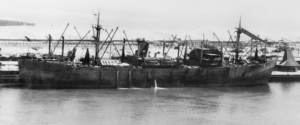
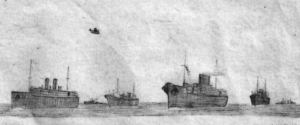
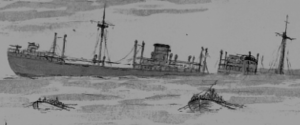
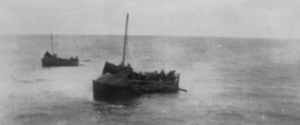
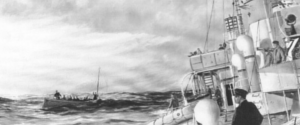
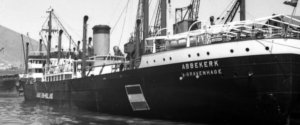



Harry Glad you made it. I was on the Kota Gede
and kept a small diary. We departed Tjilatjap a t 8 p.m. on Feb 27th. I have a book by a Japanese pilot who wrote that they went to bomb the ships in the harbour on th 28th and found they had all left.
The important thing is we got away. We mayhave been hungry and very thisty for about 10 days but much better off than those who were left behind Regards Ian Robinson